November 2009
One of the legacies of modernism is a collection of established tropes that performers can dip into and retool to their liking. The video installations of Dominic Redfern recycle some of these tropes to affect an instant replay of the heroism of the modern man.
In massive screens attached to either end of the Perth Institute of Contemporary Art’s central gallery, Stonewall (2008) shows Redfern climbing the rocky slope of a hill above Queenstown, Tasmania. Here copper tailings have poisoned the landscape, producing an apocalyptic environment. This devastated scene offers the artist a site to stage a parody of romantic modernism. As he climbs, Redfern recites a stream-of-consciousness prose piece that recalls the parodies of late modern literature, by such French authors as Blaise Cendrars and Raymond Roussel. These writers are famous for playfully reworking the tropes of romantic literature to create abstract, meaningless machines of novels. They pastiche the classic ‘quest’ structure of the novel into a pointless, ridiculous escapade. The ghosts of Cendrars and Roussel linger in Stonewall as a recording of a French translation of Redfern’s monologue plays in the background, lending a Francophone cultural credibility to the piece. As Redfern writes, Stonewall is “promising significance yet consistently failing to deliver closure” (artist statement, www.dominicredfern.net).
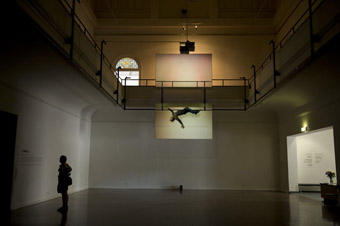
Stonewall 2008-09, Dominic Redfern
photo by Eva Fernandez, courtesy of PICA
Stonewall 2008-09, Dominic Redfern
It is between the tragedy of the masculinity on show and the comedy of its repetition that we can locate the other video pieces in the show. As a part of a series of video installations called Mythos (2007-9), Redfern is videoed walking across a salt lake, and on another screen wanders amongst grass trees, as if to mimic the loss of the modern artist in the vast Australian continent. In a piece called Emerge, again a part of the Mythos series, he surfaces from under the water of a magnificent European mountain lake. Walking onto shore, dressed in a soaking pair of jeans and a t-shirt, he picks up a branch before wandering out of shot. Once again the performance makes banal the tales of modernity, this particular tale located somewhere between Charles Darwin’s theory of evolution and Stanley Kubrick’s 2001 (1968). As Redfern occupies the place of the heroic modern protagonist, and performs a man who finds nothing at the end of the existential rainbow, his piece recollects the absences of art after modernism.
The French philosopher Jean Baudrillard has claimed that there can be no art after the Modern had exhausted the quest for art, and that contemporary art only occupies the place of an art that has in postmodern times disappeared. Redfern occupies the place of the artist in the absence of art, playing out the heroism of making an art that is not really there. He makes a tragic figure, who can only redeem himself through simulation and, like these late modern writers, parody. So it is, that the other screens of Stonewall, at the opposite end of PICA’s massive gallery, intermittently show a cardboard cutout image of Redfern falling, as if he has lost his grip on the side of the mountain. The flatness of this image renders the masochism of the solipsistic male an image like any other, to be retooled and repeated, pointlessly, by contemporary art.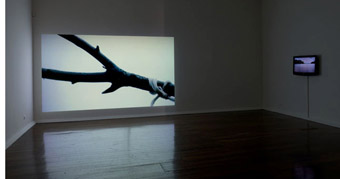
Mythos 2008-09, Dominic Redfern
photo by Eva Fernandez, courtesy of PICA
Mythos 2008-09, Dominic Redfern
Dominic Redfern, Perth Institute of Contemporary Art, Perth, 31 Oct-20 Dec, 2009
RealTime issue #93 Oct-Nov 2009 pg.
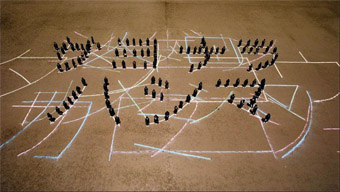
Spelling Dystopia 2009, Nina Fischer & Maroan El Sani
© the artists
Spelling Dystopia 2009, Nina Fischer & Maroan El Sani
Downstairs, in the dark of the Gallery of Modern Art’s black box Cinema B, a bevy of gorgeous, entirely naked Eurasian women cavort with a flock of bemused sheep in the stony Kazakhstani countryside. These slender beauties gleefully gorge on a roasted sheep’s head, starting with the molten eyes and then, flinging their waist-length black tresses with ecstatic abandon, writhe erotically with the animals amidst the straw, pee and liquid shit of a sheep-pen.
Set to a thumping ethno-electronic soundtrack, Almagul Menlibayeva’s sensual, telluric video Headcharge (2007) is as mesmerizing as it is perplexing. As Kathryn Weir cautions in her catalogue essay for The view from elsewhere, GoMA’s program of moving image art from Asia and the Middle East, the temptation for those schooled in Western avant-garde art traditions is to try to read this artwork in the transgressive tradition of the Viennese Aktionists, whose experiments, as Stephen Barber notes, “disassembled the human body and its acts into compacted gestures of blood…and meat.” However, as Weir goes on to note, beyond surface similarities of public nudity, freeform sexuality and “abject smears”, to place Menlibayeva’s highly specific video practice in this Western tradition is as much a misreading of the work as the other common responses—”exoticising fascination or complete misunderstanding”—to the art of ‘elsewhere’ explored in this extensive, challenging show.
Complex art such as Menlibayeva’s “Romantic punk shamanism”, which synthesises Central Asian and European references—specifically Kazakhstani cultural iconography with distinctly Western countercultural, psychedelic and Baroque flourishes—poses a unique challenge. The double gesture of familiarity and difference in this kind of work requires a viewer capable of stillness, observation, and “cultivating an openness to what is not known or cannot be known.”
The view from elsewhere offered Brisbane audiences a unique opportunity to cultivate that openness through the installed white cube show, Small acts, and the black box cinema program in which Menlibayeva’s dynamic videos were shown alongside realist documentaries and poetic short films from across the region. In Thai auteur Apichatpong Weerasethakul’s typically languid Primitive: A Letter to Uncle Boonmee (2009), a contemplative, searching camera rakes over the interiors of various wooden houses in a near-deserted village. Young soldiers dig up the ground outside one dwelling as the voices of three young men are heard repeating a letter to a man named Boonmee, about a tragedy in a small community, Nabua, which forced residents to flee their homes in panic. As a fearsome tropical wind seizes palms and banana trees and whips them into a wild frenzy, a swarm of bugs invades. Then the sky darkens, the camera tilts slowly to reveal a tracery of tree branches, and the bugs disperse. Weerasethakul’s earlier film, Like the Relentless Fury of the Pounding Waves (1996), shown with Primitive on the final Sunday of the program subtly explores four lives connected by a radio play, a “mysterious comedy and tragic drama!”, about the sea goddess Mae Ya Nang. As with countrywoman Sasithorn Ariyavicha’s meandering, reflective works (My First Film, 1991; Drifter, 1993; and Birth of the Seanema, 2004), this work is emblematic of the “dual consciousness” Mark Nash writes about in his catalogue essay, which sees international artists drawing on and developing aesthetic codes both culturally specific to Thailand, as well as histories of North American and European avant-garde and art cinema.
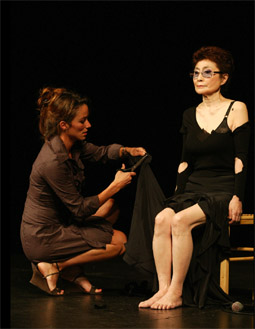
Cut Piece 2003, Yoko Ono
photo by Ken McKay © Yoko Ono
Cut Piece 2003, Yoko Ono
As the curators point out, video and performance art emerged roughly coincidentally, and the Small acts show makes explicit the links between historic performance art captured on early video and contemporary trends in video art, in which performance documentation features heavily. Nam June Paik’s pioneering Hands and Face (1961), featuring the artist passing his hands over his face in a kind of trance, frames the entry to the media gallery in which Small acts is housed. The viewer is then greeted with an installation of Yoko Ono’s Cut Piece (1964, restaged 1996). In this seminal piece, Ono sits impassively as spectators are invited to cut pieces of her clothing away; while it’s hard not to notice the way male participants are quick to refashion her a décolleté (both in the early version and the later re-staging), the video also powerfully brings together other notions of sadism/masochism, desire/exhibitionism, and reciprocity in the art exchange.
In the next room, Kimsooja’s videos, A Beggar Woman, Lagos (2001) and A Homeless Woman, Cairo (2001) feature the artist adopting the forlorn poses of society’s most vulnerable members. With her back to the audience, lying or sitting begging in a public street, Kimsooja recalls the public struggles of non-violent activists, foregrounding her body as a political object and using video as witness. The majority of works in Small acts, however, reflect the easy availability of user-friendly, cost-effective digital technology and the way early video art’s political imperatives have given way, in a large part, to smaller aims constellated around self-expression. Of the documentation of simple performance gestures, particularly memorable are the sweetly domestic games of Guy Ben-Ner, and Taiyo Kimura’s absurdist acts, as they recall early cinema’s climate of wonder and discovery, and the period before genres such as ‘documentary’—or even ‘the trick film’—had fully crystallised.
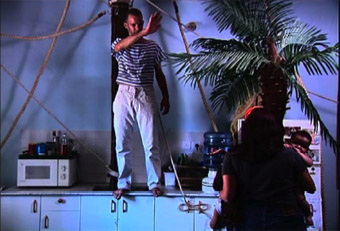
Moby Dick 2000, Guy Ben-ner
© the artist
Moby Dick 2000, Guy Ben-ner
The documentary urge, discussed at length in the catalogue essays, defines both Small acts and the cinema program of The view from elsewhere. The show offers an opportunity to explore the outermost contours of documentary form, such as in Lida Abdul’s beautiful, unexpectedly ludic In Transit, where a rusting military airplane is joyously transformed into a plaything by a group of children; the haunting found-footage explorations of Ayisha Abraham and Yoo Soon-mi; and Kyrgyzstani artist Shaarbek Amunkul’s potent ethnographic studies. Legendary filmmaker Amos Gitai’s ‘archaeological’ exploration of a single street in West Jerusalem, in Bait (House, 1980), and News from Home/News From House (2005), which centres on the displacement of a Palestinian family, the appropriation of their property, and subsequent ‘lives’ of the house, is also a lesson in the power of non-fiction film.
In the light of so much pro-filmic reality, more constructed works such as Menlibayeva’s, Mona Hatoum’s exquisite Measures of Distance (1988), and Nina Fischer and Maroan El Sani’s study of Japan’s infamous uninhabited Gunkanjima (Battleship Island) Spelling Dystopia (2009), are a breath of fresh air. In particular, Inoue Tsuki’s remarkable A Woman Who is Beating the Earth (2007), about the hard rock fantasies of a woman struggling with an abusive relationship, stands out from the rest for its bravery, wit and raw poetic force.
The view from elsewhere was an expansive exhibition, involving numerous works and requiring multiple visits. It highlighted the unique ability of the relationship between the Gallery of Modern Art and the Australian Cinémathèque to articulate, with sensitivity and scope, the dimensions of contemporary moving image practice and how, in both gallery and cinema setting, the elsewhere of the title, in Mark Nash’s words, “is not just the elsewhere of the artist’s location, but that space which opens up within the viewer when they engage with the individual works.”
Small acts, curator Kathryn Weir, Media Gallery, GoMA, July 25-15 Nov 15; The view from elsewhere, curator Kathryn Weir, Australian Cinémathèque, GoMA, Brisbane, Oct 7–Nov 15
RealTime issue #93 Oct-Nov 2009 pg.
Sue Healey is a leading, Sydney-based choreographer, described by Erin Brannigan in her introduction to a 2004 RealTime interview as “a survivor in the Australian dance scene.” Her capacity to survive in the under-funded Australian dance ecology is doubtlessly fuelled by the strength of her vision:
“I create dance that acknowledges the potency of the human body to take us into the realm of the extraordinary. I believe dance to be vital human research and as a means to communicate across cultural boundaries. I am committed to creating a theatrical language that illuminates and transforms, revealing subtle layers of movement and perception” (www.suehealey.com.au).
As a choreographer Healey appears pretty much a formalist, producing with her dancer collaborators geometrical patternings (accentuated by the poles and lines the performers dextrously manipulate in Healey’s Fine Line Terrain, 2004) that are at once taut and fluid. Finely responsive dancers like Shona Erskine, Lisa Griffiths and Nalina Wait are expert in realising Healey’s demand for heightened, abstract articulation in this dance essay about our manipulation of space as habitation.
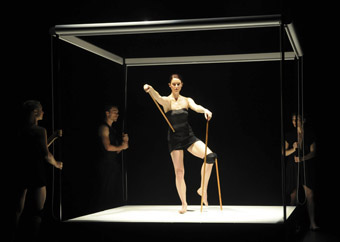
The Curiosities, Sue Healey, Performance Space
photo by Heidrun Löhr
The Curiosities, Sue Healey, Performance Space
On the other hand, in As You Take Time (2007), with its multiple performance sites and screen duplication of performers live and recorded, there’s a more open performativity, with witty filmed encounters and stagings in Japan alonside live embodied recollections of cross-cultural experiences.
What’s particularly interesting about Healey is her sense of exploration (of time, cultures, perception, body mechanics), of research become art or, better, art as research. Above all it is her preoccupation with perception (amplified by her filmmaking craft and its multimedia manifestations) that gives her body of work its enduring substance: “(Experiencing) dance, whether as observer or performer, can enhance the way we perceive our reality as moving, sentient beings interacting on this fragile planet.”
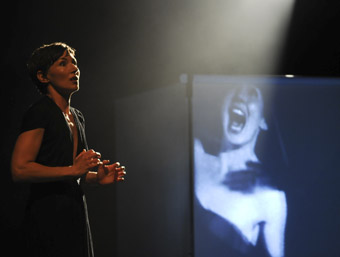
The Curiosities, Sue Healey, Performance Space
photo by Heidrun Löhr
The Curiosities, Sue Healey, Performance Space
Healey began a degree in Science at Auckland University, New Zealand, before coming to Melbourne in 1981. She graduated from the Victorian College of the Arts with a BA (Dance Performance) and then a Masters Degree in Choreography at Melbourne University. She was a founding member of Danceworks in Melbourne and performed and choreographed with the company from 1983 to 1988. In the 1990s she created works for many dance companies in Australia and has been Artistic Director of Vis-à-Vis Dance Canberra (1993-95) and the Sue Healey Company from 2002, touring the United States, United Kingdom, China, Japan and New Zealand. Her film Will Time Tell? won Best Dance Film at the 2008 Australian Dance Awards. Sue Healey was awarded the 2008 Robert Helpmann Scholarship by the NSW Ministry of Arts. Her company is touring to the International Festival of Media and Arts, Yokohama Japan in November 2009. Healey is currently a Visiting Fellow at the School of English, Media and Performance, UNSW. A review of Healey’s latest work, The Curiosities, will appear in RealTime 94.
Keith Gallasch
reviews
the body: re-examined, recreated, restless
jodie mcneilly: sue healey, the curiosities
dancing cultural time zones
keith gallasch: sue healey, as you take time
reeldance: the dance-cinema hybrid
karen pearlman: reeldance 2004
dancing the labyrinth
richard james allen: sue healey, fine line terrain
niche #2 a salon performance
erin brannigan: antistatic 2002
interviews
the slippery path
erin brannigan: time series
the fine lines of creation
erin brannigan: niche series
dancewrite workshop feature
For the 2008 RealTime-Critical Path DanceWrite workshop, Sue Healey showed and spoke to her film Will Time Tell?, after which participants wrote their responses to the work.
will time tell?: into the cultural vortex
ashley syne
will time tell?: precise moves
jane mckernan
will time tell?: multiple beings
yana taylor
will time tell?: many times
pauline manley
Video excerpt embedded with permission from the artist
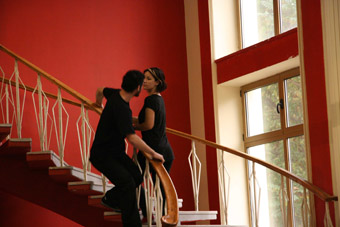
Johanna Billing, I’m lost without your rhythm 2009
photo by Lavinia German, courtesy the artist and Hollybush Gardens, London
Johanna Billing, I’m lost without your rhythm 2009
Swedish artist Johanna Billing is clearly no stranger to a striking concept. Wildly differing renditions of 80s pop song You Don’t Love Me Yet are presented as raw footage, accessible at viewing stations in Bristol’s Arnolfini Gallery. Recorded at a rolling program of global events from 2002 onwards, quavering unaccompanied vocals give way to slick retro synth and alt. rock, as viewers stay with each version for as long as individual stamina levels allow.
Billing’s work is featured as part of a collaboration between Arnolfini, London’s Camden Arts Centre and Modern Art Oxford, with the commission I’m Lost Without Your Rhythm and earlier work Magic & Loss exhibiting in Bristol over the last two months. In the first of these pieces, a performance project documented over seven days is reconstructed as a fragmented landscape of tiny increments in a 13 and a half minute video loop. A national flag, passersby, cleaning workers preparing a space, suggest a context shifting in and out of traditional performance states, as a patchwork of visual information accumulates around the event itself. The faces and limbs of non-dance trained Romanian teenagers move through a blue-carpeted studio; the formal sweep of a curving staircase and a slate-grey terrace of wide stone ledges. Disjointed, inconsequential actions give way to head rolls, sideways falls and knee rotations, building and repeating between each space, and wedded to a drumbeat and lyric-dominated soundtrack of escalating complexity. Moments of abstracted detail, a close-in lattice of crossed hands, a mesh of running shadows, appear to exist apart from the work’s formalised choreographic language, as if Billing’s creative engagement with the material is experienced more freely at one remove, breaking through in occasional sideways glances.
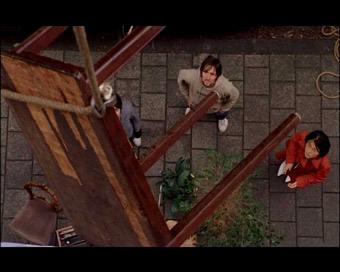
Johanna Billing, Magic and Loss 2005
Images from Magic & Loss, a 17 minute loop filmed in Amsterdam in 2005, settle and resonate, creating an ambiguous space for the viewer’s own narrative associations to arise as a group of silent 20-somethings dismantle the minutiae of domestic habitation. The absence of dialogue and use of diegetic sound allows for a focus on texture and fragility, as wine glasses are wrapped in tissue paper, books are boxed and a pliant cargo of bedding is lowered to street level from an overhead hoist. While Magic & Loss contains no recognisably codified dance content, rhythmic structure emerges from low-key internal pacing, with the weaving together of image states appearing much closer to a contemporary notion of direct screen composition. Viewing both works in adjacent spaces raises pertinent questions about visual stimuli and breathing space, external frameworks and internal phrasing, about the amorphous, process-driven nature of screen choreography, and of the impossibility of neatly defining product-based end results. Screendance has undergone a recent shift away from the studio, and towards the gallery. Billing’s work mirrors this shift, reflecting it back from a documentary and conceptually-oriented basis. The seamless circularity of the looped works, allowing viewing engagement to begin and end at any point, makes perfect sense of carefully constructed beginnings when viewed retrospectively as a cycle’s end—much like life.
Johanna Billing, Arnolfini, Bristol Sept 12-Nov 8
RealTime issue #93 Oct-Nov 2009 pg.


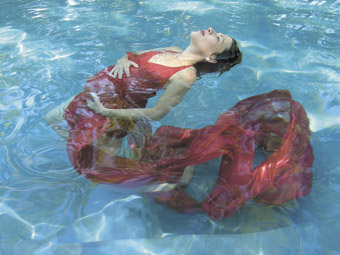
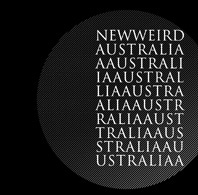 New Weird Australia is a series of free downloadable albums compiled by Stuart Buchanan and Danny Jumpertz, the team who also present the show of the same name on Sydney’s FBi radio. The naming draws inspiration from the New Weird America moniker (in turn influenced by Old Weird America), which loosely categorises a range of alternative musics such as the neo-folk stylings of Joanna Newsom and Devendra Banhart; the psychedelic jams of the No Neck Blues Band and The Sunburned Hand of Man; and the laptop-folk fusions of CocoRosie and the Animal Collective plus more. Boldly borrowed by Buchanan and Jumpertz, the Australian usage is a little more expansive incorporating electronica, contemporary classical, lo-fi electronics and laptop experimentations that dwell on the outer edges of the ‘alternative mainstream’. Two compilations have been released so far, with the third due in November and already they are exposing listeners to some great hidden treasures—from artists well known in experimental circles, and from fresh discoveries—with an impressive Australia-wide representation.
New Weird Australia is a series of free downloadable albums compiled by Stuart Buchanan and Danny Jumpertz, the team who also present the show of the same name on Sydney’s FBi radio. The naming draws inspiration from the New Weird America moniker (in turn influenced by Old Weird America), which loosely categorises a range of alternative musics such as the neo-folk stylings of Joanna Newsom and Devendra Banhart; the psychedelic jams of the No Neck Blues Band and The Sunburned Hand of Man; and the laptop-folk fusions of CocoRosie and the Animal Collective plus more. Boldly borrowed by Buchanan and Jumpertz, the Australian usage is a little more expansive incorporating electronica, contemporary classical, lo-fi electronics and laptop experimentations that dwell on the outer edges of the ‘alternative mainstream’. Two compilations have been released so far, with the third due in November and already they are exposing listeners to some great hidden treasures—from artists well known in experimental circles, and from fresh discoveries—with an impressive Australia-wide representation. 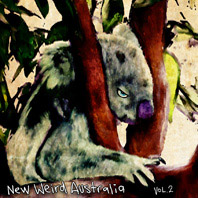 Volume Two is co-selected by Buchanan and Danny Jumpertz and steers away from the Freak Folk that is influencing Volume One, into the territory of exploratory electronica and ambient. Some of this is pretty much what we expect from electronica—which is not bad, just perhaps more neatly classifiable. Broken Chip’s “Summer Stars” offers pleasing glassy ripples and Björky-clockwork multi-rhythms. There is a similar machinic style, overlayed with a more militaristic drum exploration in Sam Price’s compelling “Auto Hackney”. Kharkov’s “Crustacean” keeps edgy by drifting swathes of sharpish tones over a subtle propulsion while Mieli’s fat beats of “Hometime”, though finely produced, offered me no weirdness at all.
Volume Two is co-selected by Buchanan and Danny Jumpertz and steers away from the Freak Folk that is influencing Volume One, into the territory of exploratory electronica and ambient. Some of this is pretty much what we expect from electronica—which is not bad, just perhaps more neatly classifiable. Broken Chip’s “Summer Stars” offers pleasing glassy ripples and Björky-clockwork multi-rhythms. There is a similar machinic style, overlayed with a more militaristic drum exploration in Sam Price’s compelling “Auto Hackney”. Kharkov’s “Crustacean” keeps edgy by drifting swathes of sharpish tones over a subtle propulsion while Mieli’s fat beats of “Hometime”, though finely produced, offered me no weirdness at all. 
